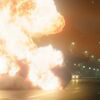What is VFX Stock Footage?
Discover how VFX stock footage helps professional VFX artists create high-quality shots faster, cheaper, and more efficiently.
You’ve seen it in blockbusters. You’ve seen it in high-end streaming shows. You’ve even seen it in commercials, trailers, and indie films.
You just didn’t know it.
That thing is VFX Stock Footage. No, not the cheesy kind with people with fake smiles drinking from an empty mug. We’re talking VFX Stock Footage: real, high-quality video elements designed for compositors. We're talking about real footage or renders of effects like fire, smoke, fog, rain, and debris that are built for easy use in visual effects shots.
VFX stock footage is one of the most widely used, yet least talked-about tools in VFX. And it’s not because it’s a shortcut. It’s because—when used well—it’s invisible.
 Try to spot the VFX stock footage in this shot. If you can't, check out this video.
Try to spot the VFX stock footage in this shot. If you can't, check out this video.
In a recent video, ActionVFX founder Rodolphe Pierre-Louis breaks down what VFX stock footage is, how it’s used, and why the world’s top studios rely on it to meet deadlines, maintain quality, and stay under budget.
Here’s a look at what VFX stock footage is, how it's used, and why the world's top studios rely on it to meet deadlines, maintain quality, and stay under budget.
If you’re new to VFX, or a studio manager wanting to learn more about how your post-production works (or just wondering why these elements exist in the first place), this is for you.
So… What Is VFX Stock Footage?
It goes by a bunch of names—VFX elements, stock assets, compositing elements—but the idea is the same:
VFX stock footage is real footage or renders of effects like fire, smoke, fog, rain, and debris that are built for easy use in visual effects shots.
Usually they’re filmed practically. Other times they’re high-end simulations rendered out and prepped for compositing. The point is, they’re already built with post-production in mind.
You’re not starting from scratch. You’re starting from something ready to go.

Why Does Everyone Use It?
Here’s the thing: you could build every single VFX element yourself. You could simulate every flame, shoot every dust burst, or spend a few hours in Embergen tweaking ash trails.
But no one actually works like that—because it’s not realistic.
(P.S. That's true even when their marketing campaigns claim they did everything themselves. More on that later...)
Turnaround Times Matter
On real productions, time isn’t a vague concept. It’s a schedule. Deadlines are tight, shots pile up fast, and you need to move.
When you can grab a real explosion filmed from 10 different angles, comp it into your scene how you want it, and keep rolling? That’s a win.
Budgets Are a Thing
Even the biggest studios have limits. Simulations and FX-heavy shoot days aren’t cheap. If you can get the same visual result with a $100 asset instead of an $8,000 setup, that’s just good math.
Don't believe us? That's how Godzilla: Minus One got an Oscar for Best Visual Effects on a $15 million budget—Shirogumi used ActionVFX stock footage.
You can watch our interview with the team at Shirogumi here:
Flexibility Wins
Need three versions of the same fog pass? Want to test different explosion types in your comp? VFX stock footage gives you the ability to explore options without the overhead of reshoots or re-sims.
It’s not about cutting corners. It’s about working smarter.
 Our team films the explosions for you. You just put them into your shot.
Our team films the explosions for you. You just put them into your shot.
“But Isn’t That Cheating?”
Only if you believe building everything yourself is a badge of honor.
The truth is, stock assets are one of the most widely used tools in VFX—period. And for good reason. It helps you get better results, faster. And if you do it right, no one will know it was stock to begin with.
You’re not cheating. You’re being efficient.
And as Bryan Haines, Senior Compositor from Crafty Apes once put it: “ActionVFX gets me home to see my family.”
Hard to argue with that.
 An ActionVFX muzzle flash asset in Stranger Things Season 4.
An ActionVFX muzzle flash asset in Stranger Things Season 4.
But What About CG vs. Real?
Let’s clear this up.
Most of our elements are shot practically—real fire, real smoke, real debris. Some others are simulated, rendered, and delivered in a way that gives you more control and consistency.
Both are valid. Both have their place. What matters is that they work in the shot.

There’s a whole camp of people who love to say “we don’t use CGI” in their marketing videos, but the truth is… most of them do. They just don’t call it that. (Yes, we're looking at you, Tom Cruise...)
(If you don't know what we're talking about, sorry to burst your bubble, but almost all the jets in Top Gun: Maverick are CG.)
The best artists care less about how an element was created, and more about what it helps them say in the scene.
Where Do You Get This Stuff?
You can shoot it yourself. You can build your own sims. But if you’d rather skip that and get straight to the part where your shot looks good, there’s ActionVFX.
We’ve got:
- Over 12,000 professional-grade elements
- Most elements filmed practically
- Everything built for compositors
- New collections added every month

Whether you or your team is working in After Effects, Nuke, Blender, Resolve, or something else, these elements drop in and get the job done.
Watch our CEO's explanation here:
ActionVFX socials: YouTube - Facebook - Instagram - X - TikTok - Linkedin



